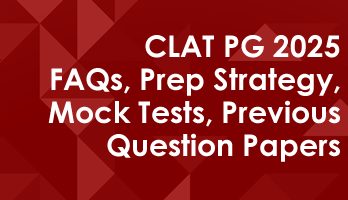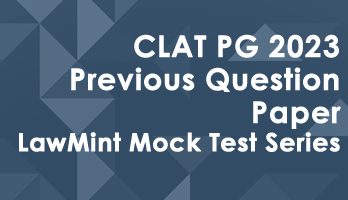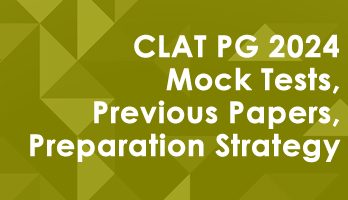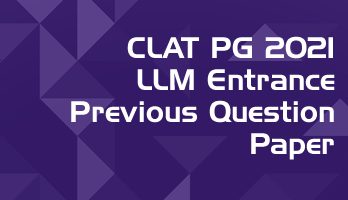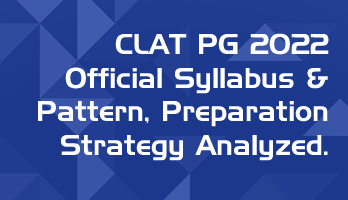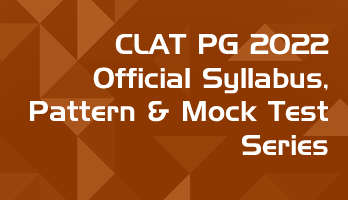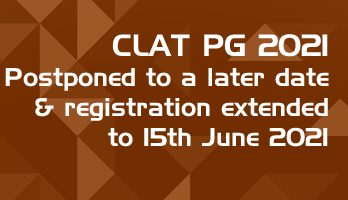- Updated as per latest CLAT PG pattern
- Overall there are 300+ comprehension passages - with 2350+ questions
- 100 passages are provided as stand-alone mini mock tests
- 120 passages are combined to form 10 full-length mock tests
- 2020, 2021, 2022, 2023 and 2024 (New Pattern) Question papers included as mock tests
- Answers include the reason or 'rationale' for better understanding
- Order of the questions and answer choices are shuffled in every attempt for better practice
- The passages are of various lengths and complexities for better practice
- Unlimited access & practice - valid for one year from date of purchase
- Accessible 24 x 7 via Smart-Phone browsers and Desktops
- More the 100 LawMint users were selected by various top NLUs in 2020, 2021, 2022 and 2023 - Including NLSIU, NALSAR, NLU-J, WBNUJS
- Our users were also selected for the IIT KGP LLM, NLU Delhi (AILET PG) & DU LLM programs
Also included in the pack : (Useful for non-CLAT LLM entrance exams) :
- 11 CLAT PG old pattern previous Papers - 2009 to 2019 (as mock tests)
- 50 full-length old MCQ format mock tests (100 questions each)
- 50 old pattern MCQ mini-mock tests (25 questions each)
- Summarized overview of Important Jurisprudence topics (For Subjective & Objective questions)
- Overview of all Constitutional Amendments
- All Tests & Previous Papers are timed and have Negative marking for realistic simulation
- Questions & Answer Choices randomly shuffled in every attempt for better practice
Authentic Feedback from previous LawMint users :
I got AIR 21 in CLAT PG. Thank you so much. Your mocks helped me a lot in my preparation 🙂 - Ayushi Jain
I have subscribed to your CLAT PG program and got AIR 36 in this year CLAT PG. I have also secured AIR 54 in AILET PG exam. I would like to thank you. Your mock paper really helps a lot - Shrashank Tripathi
I would like to thank you for the CLAT PG LLM COURSE. Practising mock tests there helped me in getting confidence and hence I was able to get AIR 45 in CLAT PG LLM - Akshay Awasthi
A year back, I relied on the IIT Kharagpur RGSOIPL mock test series by LawMint to prepare for my RGSOIPL entrance test. Few months back, I relied on your UGC NET Law series to prepare for UGC NET. I was the topper of the RGSOIPL entrance, and have cracked JRF in UGC NET. All thanks to LawMint - Anshuman Sahoo
"I got AIR 18 in CLAT PG and General Category rank 28 in AILET PG. I want to thank you for helping me practice well in controlled conditions from any place. It gave me a lot of confidence and I took the tests while travelling too. I also made it to IIT Kharagpur." - Vinodharani
"Lawmint has been of great help to me in securing AIR 25 in AILET PG and AIR 29 in CLAT PG examinations. The subjective and objective approach of the test series kept me up to date with the latest exam pattern." - Bhawna Nanda
"I, Nimmy Saira Zachariah joined you clat test series. I cleared AILET PG with 30th rank. Your test series were of immense help as it gave me clear idea of where my preparations stand thank you once again law mint." - Nimmy S Z
"Hey guys. Where do I start? If I thought that getting AIR 59 in Clat PG was it, then how wrong I was. With Lawmint now I have cracked UGC NET as well." - Joyanta Chakraborty
Note : This is not the complete question paper. This article only has the question headers from the CLAT PG 2018 question paper for overview and analysis purposes. The complete questions, with the official answer keys for all CLAT PG LLM papers published on LawMint are included in LawMint.com Practice Pack.
The actual CLAT PG 2018 question paper consists of three sections. Each section has 50 questions. However, the question below have been randomly shuffled.
Note : The official CLAT PG 2018 question paper may have less number of questions as some of them may have been deleted after the final review. We have added additional questions to maintain the number at 150.
1. A transport company issued a circular to all its drivers that they should not compete or obstruct other buses plying in the route. Driver A, in contravention of the express prohibition, obstructed another bus and while doing so met with an accident in which B was injured.
2. Which of the following reasons led to the setting aside of the practice of ‘talaq-ebiddat’, triple talaq in Shayara Bano v. Union of India (2017) 9 SCC 1?
(i) Section 2 of the Muslim Personal Law (Shariat) Application Act, 1937 was a pre-constitutional legislation within the meaning of Article 13(1) and violative of Article 14 of the Constitution of India on the ground of arbitrariness.
(ii) Section 2 of the Muslim Personal Law (Shariat) Application Act, 1937 was a pre-constitutional legislation within the meaning of Article 13(1) and violative of Article 15 of the Constitution of India, being discriminatory.
(iii) Muslim Personal Law (Shariat) Application Act, 1937 is not a law regulating triple talaq but the practice of triple talaq was against the basic tenets of the Holy Quran and no practice against the tenets of Quran was permissible.
(iv) ‘Talaq-e-biddat’ is integral to the religious denomination but the Supreme Court may injunct this practice as a means for severing matrimonial relationship.
Choose the correct answer from the following:
3. The Supreme Court in Indian Medical Association v. V P Shanta, (1995) 6 SCC 651, has held that:
4. “Sociology of law must begin with the ascertainment of the living law, the concrete which can be observed and not the abstract”. Who said so?
5. In which of the following decisions the Supreme Court framed guidelines for safeguarding the interest of the death row convicts?
6. “The suppression of vice is as much the law’s business as the suppression of subversive activities.” Who made this observation?
7. Which of the following Commission(s) has/have a constitutional status, as of April, 2017?
(i) National Commission for Scheduled Castes
(ii) National Commission for Backward Classes
(iii) National Commission for Scheduled Tribes
(iv) National Human Rights Commission
8. Which of the following Fundamental Rights is enforceable against private individuals?
(i) Article 17
(ii) Article 23
(iii) Article 24
(iv) Article 21
Choose the correct answer from the following:
9. Who among the following is called as “Darwinian before Darwin”, because of his contribution to apply the evolutionary principle to the development of the legal system?
10. What is the minimum number of judges required to constitute a Constitution Bench in the Supreme Court of India?
11. Under which provision of the Companies Act, 2013, will members be liable for a reduction of the statutory minimum number of members, in the Company?
12. Who defined ownership as ‘a right – indefinite in point of user – unrestricted in point of disposition – and unlimited in point of duration’?
13. In which among the following cases did the Supreme Court hold that the petitioners have no fundamental right within the meaning of Art 25 or 26 to perform ‘Tandava dance’ in public streets and public places.
14. Article 29 of the Constitution protects the rights of:
15. Who said, “A precedent, therefore, is a judicial decision which contains in itself a principle. The underlying principle which thus forms its authoritative element is often termed the ratio decidendi.”?
16. Which one of the following has powers similar to those of a Court having power to issue a writ of certiorari under the express statutory provisions?
17. In which of the following cases did the Supreme Court hold that the Wednesbury rule was applicable in administrative actions?
18. In which of the following cases, the Supreme Court refused to give any relief to the petitioner(s) under Article 32?
19. The Supreme Court of India recognised ‘transgenders’ as ‘third gender with all rights’ in the case of:
20. For prevention of corruption, provisions have been made under which of the legislations?
(i) The Prevention of Corruption Act, 1988
(ii) The Lokpal and Lokayuktas Act, 2013
(iii) The Central Vigilance Commission Act, 2003
Choose the correct answer from the following:
21. Right to life includes right to reputation was recognised in:
22. Which one of the following drafted the hypothetical Case of the Speluncean Explorers?
23. Which among the following is not true with respect to negotiable instruments?
24. A entrusted his car to B for plying it as a taxi. B employed C as a cleaner. B gave the taxi to C for taking a driving test and to obtain a driving licence. C while giving the driving test seriously injured D. D filed a case against A, the owner of the vehicle.
25. The term ‘transcendental idealism’ is applied to the epistemology of
26. Which of the following statements is incorrect in view of the judgment in Pramati Educational and Cultural Trust v. Union of India (2014) 8 SCC 1?
27. Which of the following reason(s) was/were considered necessary for the Constitution (Seventy-Seventh) Amendment Act, 1995 inserting Article 16(4A)?
(i) Inadequacy of representation of the Scheduled Castes and the Scheduled Tribes in services in the States.
(ii) Reservation in promotion was held constitutionally impermissible in Indra Sawhney v. Union of India, AIR 1993 SC 477.
(iii) To prevent qualitative exclusion of the Scheduled Castes and the Scheduled Tribes in services in the States.
(iv) To achieve inter-locking in horizontal and vertical reservation among the Scheduled Castes and the Scheduled Tribes in services in the States.
Select the correct answer from the following:
28. With which amendment was clause 4 to Article 13, Constitution of India, inserted?
29. Pound’s theory of Social Engineering mainly talks about
30. H and W, both professing Muslim faith marry under the Special Marriage Act, 1954. In course of time they are blessed with two sons and two daughters. The eldest child, S1 was very successful and made a lot of money while the rest of the family members were in dire financial circumstances. He maintained a separate habitation, refused to share his money and executed a Will of his total property in favour of a trust before his death at the age of 44 excluding completely his younger siblings and old parents. The Will would be
31. Judicial Review deals with:
32. The last trial by jury held in a criminal case in India was that of
33. Law is a combination of Primary and Secondary rules. This principle was propounded by
34. The National Judicial Appointments Commission Act, 2014 was declared as unconstitutional and void in:
35. Which of the following is a right in re aliena?
36. Which among the following was the first case before the Supreme Court of India where the constitutionality of death penalty was challenged?
37. The first Jurist to use the word Sociology was
38. Roberto Mangabeira Unger was the main propounder of
39. Double Jeopardy means:
40. In which of the following cases, the Supreme Court issued detailed directions for the protection of Good Samaritans?
41. A foreigner can acquire Indian citizenship through
42. As per the rule of English law, a custom to be recognized as law, must be proved to be in existence since times immemorial. However, for customs that are old and whose time of origin cannot be ascertained, which year has been fixed as the date before which it must have started?
43. The Preamble to the UN Charter uses the expression
44. Which of the following is not emphasised by Katherine Bartlette as a part of feminist legal research?
45. In which case, the Supreme Court struck down that part of the Constitution (Fortysecond Amendment) Act, 1976 by which Article 31C was amended?
46. A rule which says, “the literal sense of words should be adhered to, unless this would lead to absurdity, in which case the literal meaning may be modified”, can be called
47. As per Kelsen, if a norm remains permanently inefficacious, then it is deprived of its validity. This is known as
48. The right of an accused to be defended by a legal practitioner of his/her choice commences when:
49. Part IX of the Constitution of India providing for constitution of Panchayats was introduced to give effect to which provision of the Constitution?
50. The fundamental principle of non-refoulement in International Law is applied in relation to:
51. The idea of single citizenship in India was taken from the
52. De Jure Belli ac Pacis is the celebrated work of
53. Which one of the following statements is correct?
54. Which of the following is not absolute duty according to John Austin?
55. In which case was it held that the authority which “embarks upon a post-decisional hearing will naturally proceed with a closed mind and there is hardly any chance of getting a proper consideration of the representation at such a post-decisional opportunity”?
56. Who made the statement, “Law is uncertain and certainty of law is a legal myth”?
57. Which of the following is an accessory right?
58. A mortgage by deposit of title deeds for which a loan of Rs 3 crores is raised
59. Jus Cogens means:
60. The Constitution (One Hundred and First) Amendment Act, 2016 was required to be ratified by the Legislature of not less than one half of the State Legislatures because it sought to make changes in:
(i) Chapter I of Part XI of the Constitution dealing with legislative relations between the Union and the States.
(ii) Lists I and II of the Seventh Schedule to the Constitution.
(iii) The Sixth Schedule to the Constitution.
(iv) Part XIII of the Constitution dealing with trade, commerce and intercourse within India. Select the correct answer from the following:
61. Which Constitution (Amendment) Act brought about modifications to Fundamental Rights, Directive Principles of State Policy as well as Fundamental Duties?
62. In which among the following cases did the Supreme Court observe: “We cannot allow our judicial thinking to be constricted by reference to the law as it prevails in England or for that matter, in any other foreign country. We no longer need the crutches of a foreign legal order.”
63. Which one of the legal propositions is correct?
64. Which among the following authorities is vested with the power to investigate on matters of professional misconduct committed by a Chartered Accountant or a Chartered Accountant’s Firm under Section 132 of the Companies Act, 2013?
65. A, a singer, enters into a contract with B, the manager of a theatre, to sing at his theatre two nights every week during the following two months, and B agrees to pay Rupees 100/- for each night’s performance. On the sixth night A wilfully absents herself from the theatre.
66. Who stated that, “Law is the sum of the conditions of social life in the widest sense of the term, as secured by the power of the State through the means of external compulsion.”
67. Note : The original question the should have come here was officially deleted from the CLAT PG 2018 exam. We have replaced it with a similar question for continuity.
Consider the following statements :
1. A person who has held office as a permanent as a permanent Judge of a High Court cannot plead or act in any court or before any authority in India except the Supreme Court
2. A person is not qualified for appointment as a Judge of a High Court in India unless he has for at least five years held a judicial office in the territory of India
Which of the statements given above is/are correct ?
68. Jurisprudence should be ideally divided into censorial and expository jurisprudence. This view was given by
69. According to the Hindu Marriage Act, a marriage is
70. In which case was it observed that “The dividing line between an administrative power and a quasi-judicial power is quite thin and is being gradually obliterated”?
71. Which of the following is not correct about the Critical Legal School?
72. Which of the following statement(s) is/are correct, regarding the duties and rights of the Attorney-General for India in performance of his duties?
(i) The Attorney-General for India shall give advice to the Government of India upon legal matters.
(ii) The Attorney-General for India shall have a right to audience in all Courts in India.
(iii) The Attorney-General for India shall have the right to speak in the proceedings of either House.
(iv) The Attorney-General for India shall not be liable to any proceedings in any court in respect of anything said by him in Parliament or any committee thereof.
73. Which of the following is not a special procedure or feature in respect of a Money Bill?
74. The rule of Daniels v Davison (1809) 16 Ves 249, has been given a statutory shape in the Transfer of Property Act, 1882, under, which of the following titles?
75. Which of the following provision(s) applicable to the Supreme Court is/are also applicable to the High Courts?
(i) Article 124(4).
(ii) Article 124(5).
(iii) Article 129
(iv) Article 144
Select the correct answer from the following:
Continued in Page 2 …
Note : This article only has the question headers from the CLAT PG 2018 question paper for overview and analysis purposes. The complete questions, with the official answer keys for all CLAT PG LLM papers published on LawMint are included in our Practice Pack.
- Updated as per latest CLAT PG pattern
- Overall there are 300+ comprehension passages - with 2350+ questions
- 100 passages are provided as stand-alone mini mock tests
- 120 passages are combined to form 10 full-length mock tests
- 2020, 2021, 2022, 2023 and 2024 (New Pattern) Question papers included as mock tests
- Answers include the reason or 'rationale' for better understanding
- Order of the questions and answer choices are shuffled in every attempt for better practice
- The passages are of various lengths and complexities for better practice
- Unlimited access & practice - valid for one year from date of purchase
- Accessible 24 x 7 via Smart-Phone browsers and Desktops
- More the 100 LawMint users were selected by various top NLUs in 2020, 2021, 2022 and 2023 - Including NLSIU, NALSAR, NLU-J, WBNUJS
- Our users were also selected for the IIT KGP LLM, NLU Delhi (AILET PG) & DU LLM programs
Also included in the pack : (Useful for non-CLAT LLM entrance exams) :
- 11 CLAT PG old pattern previous Papers - 2009 to 2019 (as mock tests)
- 50 full-length old MCQ format mock tests (100 questions each)
- 50 old pattern MCQ mini-mock tests (25 questions each)
- Summarized overview of Important Jurisprudence topics (For Subjective & Objective questions)
- Overview of all Constitutional Amendments
- All Tests & Previous Papers are timed and have Negative marking for realistic simulation
- Questions & Answer Choices randomly shuffled in every attempt for better practice
Authentic Feedback from previous LawMint users :
I got AIR 21 in CLAT PG. Thank you so much. Your mocks helped me a lot in my preparation 🙂 - Ayushi Jain
I have subscribed to your CLAT PG program and got AIR 36 in this year CLAT PG. I have also secured AIR 54 in AILET PG exam. I would like to thank you. Your mock paper really helps a lot - Shrashank Tripathi
I would like to thank you for the CLAT PG LLM COURSE. Practising mock tests there helped me in getting confidence and hence I was able to get AIR 45 in CLAT PG LLM - Akshay Awasthi
A year back, I relied on the IIT Kharagpur RGSOIPL mock test series by LawMint to prepare for my RGSOIPL entrance test. Few months back, I relied on your UGC NET Law series to prepare for UGC NET. I was the topper of the RGSOIPL entrance, and have cracked JRF in UGC NET. All thanks to LawMint - Anshuman Sahoo
"I got AIR 18 in CLAT PG and General Category rank 28 in AILET PG. I want to thank you for helping me practice well in controlled conditions from any place. It gave me a lot of confidence and I took the tests while travelling too. I also made it to IIT Kharagpur." - Vinodharani
"Lawmint has been of great help to me in securing AIR 25 in AILET PG and AIR 29 in CLAT PG examinations. The subjective and objective approach of the test series kept me up to date with the latest exam pattern." - Bhawna Nanda
"I, Nimmy Saira Zachariah joined you clat test series. I cleared AILET PG with 30th rank. Your test series were of immense help as it gave me clear idea of where my preparations stand thank you once again law mint." - Nimmy S Z
"Hey guys. Where do I start? If I thought that getting AIR 59 in Clat PG was it, then how wrong I was. With Lawmint now I have cracked UGC NET as well." - Joyanta Chakraborty



